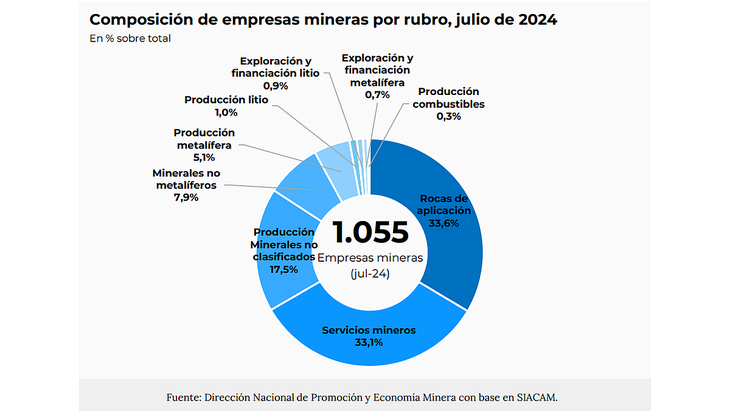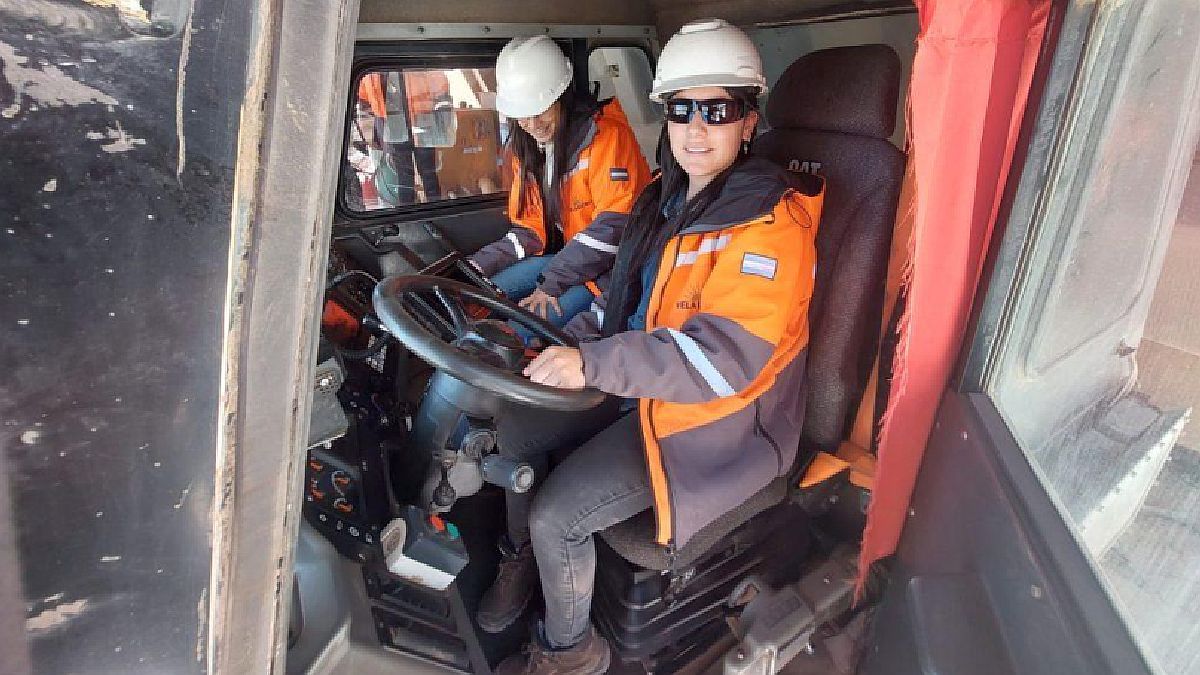In second place appears the category of services and activities related to mining, with a total of 9,228 jobs (23.3% of the total). Here there was a year-on-year increase of 1.7% (156 new positions).
Third is the application rocks sector with 5,674 jobs during July 2024 (14.3% of the total) with a notable drop of 10.5%.
In fourth place is the production of non-metallic minerals with 3,345 jobs (8.4% of the total), having a year-on-year decrease of 0.9%.
In fifth place is lithium production with 2,994 jobs (7.5% of the total), marking a year-on-year increase of 0.9%. It is highlighted that it was the mining production area with the highest interannual growth rate.
image.png
In sixth place is the production of fuel minerals with 2,208 jobs (5.6% of the total), which had an interannual decrease of 1.5% in July.
In seventh place is the exploration and financing of lithium mining with 2,045 jobs (5.2% of the total), which in July 2024 had a year-on-year increase of 43.0% (615 new positions). This defines that it is the sector that generated the most employment in absolute terms.
In eighth place is the production of minerals not previously classified with 1,659 jobs (4.2% of the total), which in the same month of 2023, had an interannual decrease of 9.5%. And finally, in ninth place is the exploration and financing of metal mining with 1,290 jobs (3.3% of the total), which for that month had a year-on-year decrease of 1.1%.
How many companies are there in the mining sector?
The report indicates that in July 2024 a total of 1,055 mining companies, 55 less than in July 2023, marking a year-on-year decrease of 5.0% in the number of companies in the sector.
From the Ministry of Mining they detailed that “Given the level of employment mentioned, it is observed that the average mining company has 38 employees”, where “33.6% (354) of the companies in July corresponded to the application rocks category.”
In second place is the category of services and activities related to mining, explaining 33.1% (349). In third place is the production of minerals not previously classified with 17.5% (185) and, in fourth place, the production of non-metalliferous minerals with 7.9% (83) of the total. The companies in these sectors registered, on average, 16, 26, 9 and 40 employees respectively.
From the national body they highlighted that the mining sector of metal production by July 2024 has 5.1% (54) of the mining companies, noting that “however, it explains 28.3% of employment in the sector, taking into account year-on-year a decrease in the number of companies of 5.3% (3 companies less).”
image.png

On average, companies in this area have a payroll of 208 employees, although it should be mentioned that only 10 companies accumulate 82% of employment in this area and have an average of 923 employees.
Regarding companies linked to lithium extraction, 1.0% (11) were registered in July 2024, with an average number of 272 employees each, where four companies concentrated 87% of the employment in this area, accounting on average 655 employees each.
By July 2024, the areas of lithium exploration and financing and metal mining explain 0.9% (9) and 0.7% (7 companies) of the total companies respectively. The companies in these two sectors registered, on average, 227 and 184 employees respectively. Finally, only 3 companies (0.3% of the total) are in the field of fuel mineral production, having, on average, 736 employees each.
Female participation grows
The hard work done to the inclusion of women in mining continue to give the expected results. Although we are still far from the desired objective, the level of participation of women in the industry is gradually growing, reaching 5,010 jobs in July of this year, which represented 12.6% of employment. total miner.
This growth is also represented in the increase in 9.4% year-on-year (429 additional positions), while male mining employment decreased by 1.7% year-on-year (612 fewer positions for the sector).
In this way, between the months of January and July 2024, the number of female mining positions remained almost unchanged.
image.png

Participation of women in mining sector by sector
The study, whose data belongs to July of this year, indicates that the category of metal projects in production was the one in which the most women occupied with 1,426 (28.5% of female mining employment) jobs that represent 12.7% of employment in the sector, achieving an increase of 11.6% year-on-year, generating 148 new positions for women in the period.
In turn, the exploration and financing of metal mining It employed 158 women (3.2% of female mining employment), representing 12.2% of the sector, with an interannual growth of 6.8%.
Regarding the sector of services and activities related to mining, it employed 985 women (19.7% of female mining employment), representing 10.7% of the sector. In interannual terms it had an increase of 17.3%, creating 145 new positions for women in the field.
The arrival of lithium It came with an important opening for women to enter the industry. In the case of lithium production, which in July employed 597 women (11.9% of female mining employment), representing 19.9% of the sector, placing it as the second sector with the highest female participation, there was a year-on-year decrease. 3.4% year-on-year.
In turn, the lithium mining exploration and financingemployed 470 women (9.4% of female mining employment) who participate in 23.0% of employment in the sector, and in the comparison of the same month of 2023 it had an interannual increase of 42.4% (140 new positions feminine). These numbers indicate that it is the area with the highest female participation.
The category of production of non-metallic minerals It employed 447 women (8.9% of female mining employment) and accounted for 13.4% of employment in the sector. Compared to July 2023, female employment in this area increased by 3.2%.
The application rocks In July 2024, it employed 445 women (8.9% of female mining employment), representing 7.8% of employment in the sector. In interannual terms it had a decrease of 2.2%. In the case of the production of fuel minerals, 242 women were employed (4.8% of female mining employment), covering 11.0% of employment in the sector, maintaining the number of female positions in year-on-year terms.
Lastly, the production sector unclassified minerals It previously employed 240 women (4.8% of female mining employment), representing 14.5% of employment in the sector, with an increase of 1.3% in year-on-year terms.
Source: Ambito




